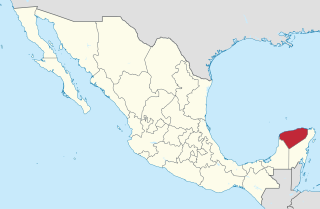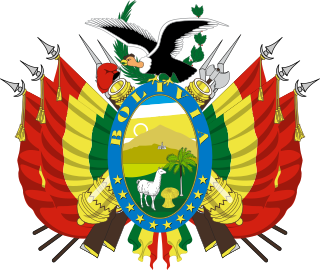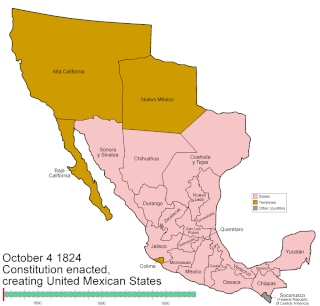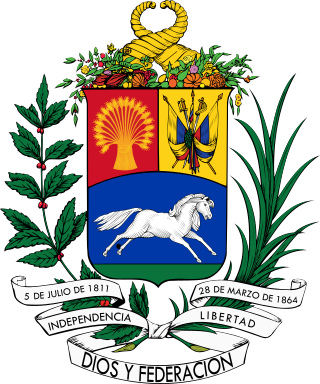
Yucatán, officially the Free and Sovereign State of Yucatán, is one of the 31 states which, along with Mexico City, constitute the 32 federal entities of Mexico. It comprises 106 separate municipalities, and its capital city is Mérida.

The United Mexican States is a federal republic composed of 32 federal entities: 31 states and Mexico City, an autonomous entity. According to the Constitution of 1917, the states of the federation are free and sovereign in all matters concerning their internal affairs. Each state has its own congress and constitution.

Quintana Roo is a state in southeast Mexico established out of the Quintana Roo Territory in 1974 with seven municipalities, which has since grown into eleven municipalities. According to the 2020 Mexican census, it has the twenty-fourth largest population of all states with 1,857,985 inhabitants and is the 19th largest by land area spanning 44,705.2 square kilometres (17,260.8 sq mi).

Yucatán is a state in southeastern Mexico that is divided into 106 municipalities, organized into 7 administrative regions. According to the 2020 Mexican census, it is the twenty-second most populated state with 2,320,898 inhabitants and the 20th largest by land area spanning 39,524.4 square kilometres (15,260.5 sq mi).

The current Constitution of Bolivia came into effect on 7 February 2009 when it was promulgated by President Evo Morales, after being approved in a referendum with 90.24% participation. The referendum was held on 25 January 2009, with the constitution being approved by 61.43% of voters.

Mexico has experienced many changes in territorial organization during its history as an independent state. The territorial boundaries of Mexico were affected by presidential and imperial decrees. One such decree was the Law of Bases for the Convocation of the Constituent Congress to the Constitutive Act of the Mexican Federation, which determined the national land area as the result of integration of the jurisdictions that corresponded to New Spain, the Captaincy General of Yucatán, the Captaincy General of Guatemala and the autonomous Kingdoms of East and West. The decree resulted in the independence from Spain.

The Republic of Yucatán was a sovereign state during two periods of the nineteenth century. The first Republic of Yucatán, founded May 29, 1823, willingly joined the Mexican federation as the Federated Republic of Yucatán on December 23, 1823, less than seven months later. The second Republic of Yucatán began in 1841, with its declaration of independence from the Centralist Republic of Mexico. It remained independent for seven years, after which it rejoined the United Mexican States. The area of the former republic includes the modern Mexican states of Yucatán, Campeche and Quintana Roo. The Republic of Yucatán usually refers to the second republic (1841–1848).
Bolivia has recognised same-sex civil unions since 20 March 2023 in accordance with a ruling from the Plurinational Constitutional Tribunal. The court ruled on 22 June 2022 that the Civil Registry Service (SERECI) is obliged to recognise civil unions for same-sex couples and urged the Legislative Assembly to pass legislation recognising same-sex unions. The court ruling went into effect upon publication on 20 March 2023. The ruling made Bolivia the seventh country in South America to recognise same-sex unions.

State governments of Mexico are those sovereign governments formed in each Mexican state.

Bolivia has had seventeen constitutions, including the present one, since its foundation in 1825.

The Political Constitution of the Mexican Republic of 1857, often called simply the Constitution of 1857, was the liberal constitution promulgated in 1857 by Constituent Congress of Mexico during the presidency of Ignacio Comonfort. Ratified on February 5, 1857, the constitution established individual rights, including universal male suffrage, and others such as freedom of speech, freedom of conscience, freedom of the press, freedom of assembly, and the right to bear arms. It also reaffirmed the abolition of slavery, debtors' prisons, and all forms of cruel and unusual punishment such as the death penalty. The constitution was designed to guarantee a limited central government by federalism and created a strong national congress, an independent judiciary, and a small executive to prevent a dictatorship. Liberal ideals meant the constitution emphasized private property of individuals and sought to abolish common ownership by corporate entities, mainly the Catholic Church and indigenous communities, incorporating the legal thrust of the Lerdo Law into the constitution.
Most Mexican states do not have an official flag. For these states, a de facto flag is used for civil and state purposes. State flags of Mexico have a 4:7 ratio and typically consist of a white background charged with the state's coat of arms.
The Political Constitution of the State of México the constitution of the State of Mexico. The previous constitutions of 1827, 1861, and 1870 were replaced in 1917.
Mexican immigration to Cuba comprises people who emigrated from Mexico to Cuba and their descendants. Cuba is home to the most Mexicans living in the Caribbean. The waves of migration from Mexico to Cuba started from the 1970s, attracted by a mild climate.

Hacienda Cacao is located off the Carretera Uman-Hopelceh within Abalá Municipality, Mexico, and is in the South West Region 8 area of the State of Yucatán. It is one of the properties that arose during the nineteenth century henequen boom, and was owned by José María Ponce.

Pedro Sáinz de Baranda y Borreiro was a naval officer, industrialist, and liberal politician who founded the Mexican Navy and led the naval blockade of Veracruz, which ended with the Spanish surrendering San Juan de Ulua Fort in 1825, the last portion of Mexican territory still in Spanish hands. This event is recognized as the culmination of the Mexican War of Independence.

The flag of Yucatán is the flag used by the former Republic of Yucatán, when in the middle of 19th century it was proclaimed in the territory of the Yucatán Peninsula. The republic comprised the present Mexican states of Yucatán, Campeche and Quintana Roo.

The Constitution of Venezuela of 1811 was the first Constitution of Venezuela and Ibero-America, promulgated and written by Cristóbal Mendoza and Juan Germán Roscio, being sanctioned by the Constituent Congress of 1811 in the city of Caracas on December 21, 1811. It was overthrown on July 21, 1812 by the capitulation of Francisco de Miranda in San Mateo. The constitution was in force for exactly seven months.

The Constitution of Venezuela of 1891 was a Constitution subscribed by all the members of the National Legislature on April 9, 1891, mainly promoted by President Raimundo Andrueza Palacios. It had 8 titles, each with 1 or 7 sections, and a total of 122 articles, among which the following stand out:














